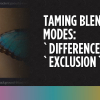
We talk a lot about needing to improve the ethics of our supply chains when it comes to mineral extraction and factory conditions, but we need protections for knowledge workers too!

We talk a lot about needing to improve the ethics of our supply chains when it comes to mineral extraction and factory conditions, but we need protections for knowledge workers too!
Given the pandemic, I have not had a chance to visit the Inclusive Tech Lab at Microsoft yet, but I love that it exists and how it is shaping the future of technology.

I have mixed emotions about this move to repurpose the utterly terrifying Boston Dynamics robots as service robots, but there are some upsides too.

Before I get into this, let me start with this preface: I am not a legal expert by any means. I never even watched Law & Order. That said, I am keenly interested in the law and how it relates to bias and discrimination, particularly if that intersects with technology, especially the web. Which brings me to the subject at hand: 303 Creative LLC v. Elenis. I tweeted about this case, which is currently before the Supreme Court of the United States, the other day, but felt like I owed it a lengthier—and perhaps more enduring—discussion. So here goes…

My latest article is a part of the HTMHell Advent Calendar and takes you through all the ins and outs of form controls used to enable people to choose one option from many: select, input[type=radio], and input[list].
difference and exclusion
Amazingly deep article on CSS blend modes. Incredible work from Ana Tudor.
:has()
If you were a fan of quantity queries, you’re going to love being able to style a parent element based on how many children it has. Awesome post from Bramus!
This is an amazingly deep dive into the world of radial gradients in CSS. It includes a ton of practical examples and a thorough dissection of the syntax and what you can do with them.
🤯

If you live in the U.S., please take the time to learn the real history of Thanksgiving, rather than clinging to the B.S. we were taught in school. This week’s episode of Native Opinion is a good place to begin that journey.

This is awesome to see. GOV.UK is going to be replacing their search functionality. The contract is estimated to be worth £900,000. The kicker’s below:
Work to replace GOV.UK’s search infrastructure is due to begin in early next year, with the initial phase of the project dedicated to identifying and evaluating products. Such assessments will be focus on “functional and non-functional requirements, based around user needs [and] include accessibility requirements… and progressive enhancement”.